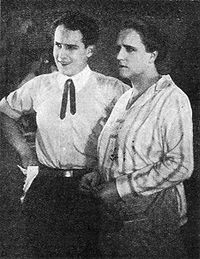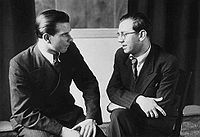- Osvobozené divadlo
-
Osvobozené divadlo (1926–1938) (Liberated Theatre or Prague Free Theatre) was a Prague avant-garde theatre scene founded as the theatre section of an association of Czech avant-garde artists Devětsil (Butterbur) in 1926. The theatre's beginnings were strongly influenced by Dadaism and Futurism, later by Poetism (a specific Czech art movement). The theatre was also very leftist oriented, however, it was critical also towards communists.[1] One of the founders, Jiří Frejka, came up with the name in 1926. In the theatre both authorial plays and works by well-established modern authors; such as G. Apollinaire, A. Jarry, J. Cocteau, A. Breton, F. T. Marinetti, and V. Nezval were performed. The modern conception of the scene also laid more emphasis on lighting and the theatrical conception adjured more cooperation and contacts between actors and audience.
Contents
History
Beginnings
 Jiří Voskovec (left) in the film Pohádka máje, 1926
Jiří Voskovec (left) in the film Pohádka máje, 1926
The first performance took place on February 8, 1926, with the play Georges Dandin by Molière (it was renamed to Cirkus Dandin), the performance was not very successful.[2] In 1927 the theatre moved to Umělecká beseda and in that time Jiří Voskovec and Jan Werich first appeared on the stage with their own play Vest Pocket Revue (a montage of dadaist gags, intellectual humour and jazz songs). The performance achieved great acclaim and Werich with Voskovec became a part of the ensemble. In the same year young pianist and composer Jaroslav Ježek joined in, and together with Werich and Voskovec represented the core of the theatre group during its whole existence. They used masks inspired by clowns fratellini, Voskovec´s mask was inspired by François Fratellini and Werich´s one by Albert Fratellini. Jiří Frejka together with another important exponent and founder, E. F. Burian, left the theatre due to disputes with director Jindřich Honzl (an avant-garde theatre theorist who directed all plays of Osvobozené divadlo). The foursome (Voskovec, Werich, Ježek, and Honzl), but mainly Voskovec and Werich, gradually became the most important part of the group and their cooperation and contribution is considered as very distinctive and legendary till now.[3]
The performances of Osvobozené divadlo till 1932 were rather of entertaining character, the program was rehearsed very loosely, it was based mainly on improvisation and was also dependent on reactions of the audience. V+W in their plays worked mainly with historical themes and exotic places (plays Sever proti jihu, Golem, Nebe na zemi, Fata morgana, Ostrov Dynamit, Smoking Revue), the performances were richly accompanied by Ježek's jazz-influenced music and songs. In 1931 Ježek also established a partnership with Karel Ančerl, later chief of Czech Philharmonic. Ančerl worked in the theatre as a conductor till 1933, and markedly improved the theatre orchestra.[4]
Osvobozené divadlo also introduced so called "forbíny" (from ger. Vorbühne - forestage, front piece) - improvised dialogue on forestage, often actual reactions on political and cultural events and topics.
Since 1932 V+W came up with the first downright political play, with Caesar. In that very successful play (191 reprises[5]) the authors for the first time warned against the danger of nazism and the theatre began to be considered as political. Another strongly anti-fascist play, Osel a stín (1933), was also very leftist oriented. In 1934 Osvobozené divadlo began to present another play - Kat a blázen - the critique of nazism was very sharp, straight and consistent in that play. The play had problems with censorship and the German embassy strongly protested at the Umělecká beseda management. After continuing complaints of German offices Osvobozené divadlo was expelled from the Umělecká beseda building U Nováků Palace in 1935.
Spoutané divadlo ("The Tied Theatre")
The theatre was renamed after the expulsion to Spoutané divadlo and settled in the Rokoko Theatre at Wenceslas Square. In the one-year period were created plays Balada z hadrů (play about F. Villon), Těžká Barbora etc.
Osvobozené divadlo again
 Jiří Traxler and Jaroslav Ježek (right) in 1938
Jiří Traxler and Jaroslav Ježek (right) in 1938
In 1936, after the triumph of the play Balada z hadrů, Osvobozené divadlo came back to U Nováků Palace, but other anti-nazi plays - Svět za mřížemi, Pěst na oko and mainly Kat a blázen (its performance caused demonstrations of the fascist part of audience) - led to a prohibition of all activities. The theater was officially closed on November 10, 1938[6] and in January, 1939 Voskovec, Werich and Ježek were forced to emigrate to the USA.
1946-1948
After World War II. Werich and Voskovec (Ježek died in 1942 in New York) came back from exile and attempted to restore Osvobozené divadlo, but the social atmosphere in post-war Czechoslovakia was different and not very friendly towards their kind of satire. After the communist putch in 1948 occurred, Voskovec emigrated again and the activity of the theatre completely ceased.
Singificance
Osvobozené divadlo represented an important part of the Czechoslovakia First Republic cultural scene. It was the place where many theatre experiments occurred. Archive recordings of plays and particularly of Ježek's music and songs are popular and reissued till now.
Significant personalities
- Jan Werich
- Jiří Voskovec
- Jaroslav Ježek
- Jindřich Honzl
- Jiří Frejka
- František Filipovský
- Václav Trégl
- Jindřich Plachta
- Vladimír Šmeral
- Bohuš Záhorský
- Blanka Waleská
- Miloš Nedbal
- Zdeněk Štěpánek
- Jan Pivec
- Emil František Burian
- Jiřina Štěpničková
- Jaroslav Rössler
See also
- Dadaism
- Futurism
Notes
- ^ Voskovec and Werich - enduring symbols of pre-war Czechoslovak culture - 11-02-2005 13:50 UTC - Radio Prague
- ^ Holzknecht, p. 63
- ^ Voskovec and Werich: a fruitful cooperation that continued across the Atlantic - 15-02-2007 14:57 UTC - Radio Prague
- ^ Holzknecht, p. 301
- ^ Císař, p. 258
- ^ Holzknecht, p. 88
References
- Císař, Jan (2006). Přehled dějin českého divadla. Prague: AMU. ISBN 80-7331-072-4.
- Holzknecht, Václav (2007). Jaroslav Ježek a Osvobozené divadlo. Prague: ARSCI. ISBN 978-8086078-67-0.
External links
Categories:- Theatres in the Czech Republic
Wikimedia Foundation. 2010.
